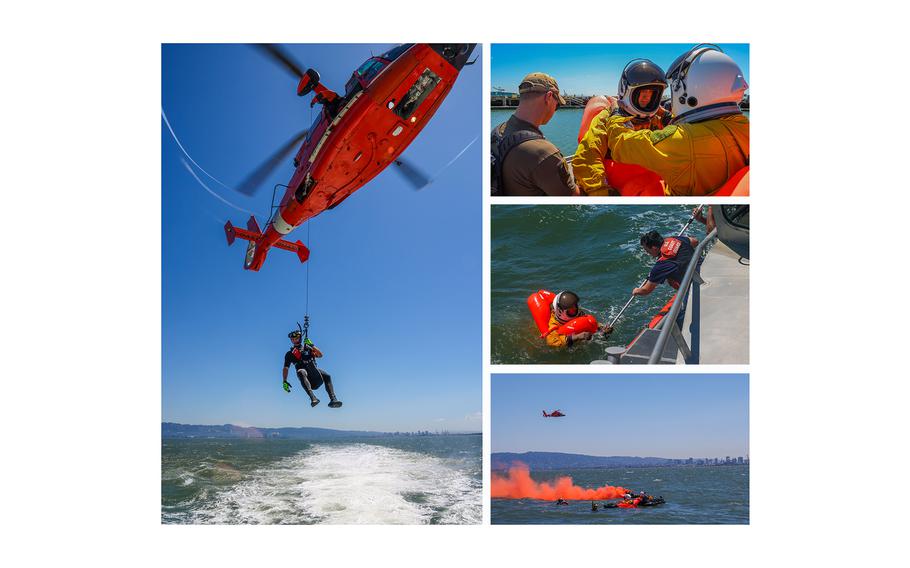
At left, a Coast Guard rescue diver lowers himself from a Eurocopter MH-65 Dolphin during a Search and Rescue Exercise in California’s San Francisco Bay on Aug. 17, 2023. At right from top to bottom: Air Force Capt. Kyle Carver, a U-2 Pilot with the 99th Reconnaissance Squadron gets help adjusting and sealing his suit at Yerba Buena island; Carver grabs hold of a rescue pole extended by Coast Guard Seaman Ethan Carter; and members of Beale Air Force Base signal to Coast Guard San Francisco Sector Search and Rescue team for evacuation from the San Francisco Bay. (Colin Smith /U.S. Air Force)
(Tribune News Service) — Beale Air Force Base partnered with the U.S. Coast Guard San Francisco sector in order to train during a recent search and rescue exercise.
Beale Airmen participated in the training exercise off the coast of Yerba Buena Island. In addition, Beale’s Surveillance, Evasion, Resistance and Escape (SERE) team along with two U-2 pilots and one T-38 pilot worked with the local Coast Guard to practice response to emergency evacuations that result in a water landing.
“Our speed in these emergency situations is critical and the only way to improve the success rate of these water evacuations is to practice them,” said U.S. Air Force Technical Sgt. Neal Troyer, 9th Operations Support Squadron SERE specialist.
This annual training helps each branch to ensure that they are performing their best if a real life emergency situation should ever arise. This joint service partnership between Beale Air Force Base and the Coast Guard is pertinent to a successful and safe retrieval of the pilot, officials said.
While many steps and procedures factor into a training exercise of this caliber, ensuring each step is clear for every participant helps translate this training into a real life event, officials said.
When a pilot finds themselves evacuating from an aircraft, there is a small piece of technology that lives in their survival equipment called a beacon. This beacon alerts both the Coast Guard and Beale with the location of the evacuated pilot. The speed of which this beacon communicates with both parties directly affects the speed they can respond.
“We always use live beacons in our training as it is the first step to mobilize the help toward the pilot,” said U.S. Air Force Technical Sgt. Alan Downs 9th Operations Support Squadron SERE specialist. “We do everything we can during the training to iron out any kinks in the beacon communication process, you never know a pilot’s condition upon landing and that means that minutes or even seconds could be the difference between life and death.”
This full day of training started on the bay while Beale’s SERE Team placed U-2 pilots, fully donned in their flight suits, into their life rafts and placed them randomly in the water with active beacons. The Coast Guard then mobilized after receiving confirmation that the active beacon was a legitimate call for assistance.
Coast Guardsman used the MH65 Dolphin helicopter to move to the location of the pilot, who by this point has activated a device called a sea dye marker that colors the water around their raft making it easier to spot them. After this, the Coast Guard lowered a large basket into the water and the pilot climbed into it, assumed a pre-trained sitting position and waited to be lifted to the helo. After the pilot was retrieved, the Coast Guard brings them back to shore while addressing any emergency needs and delivers them to the eager members of Beale.
Ensuring that these events are addressed and carried through as smoothly as possible heightens the chances of survival for the pilots involved during real life emergencies, officials said.
(c)2023 the Appeal-Democrat (Marysville, Calif.)
Visit the Appeal-Democrat
Distributed by Tribune Content Agency, LLC.